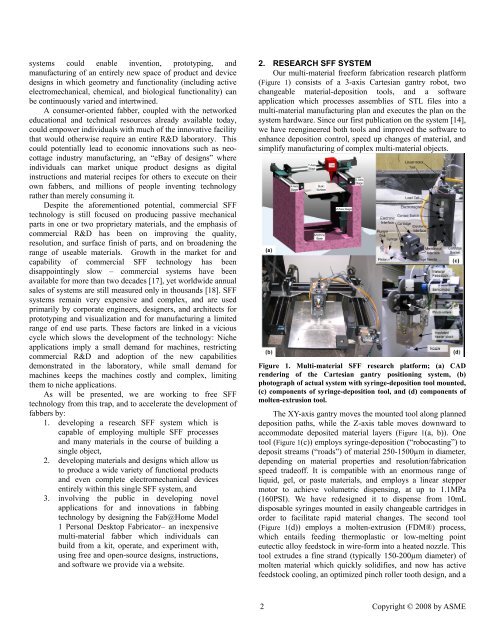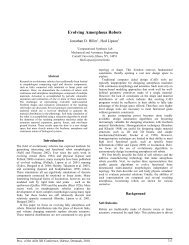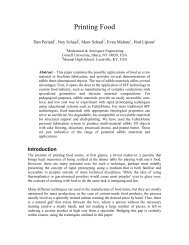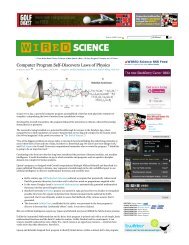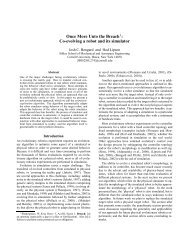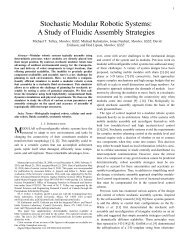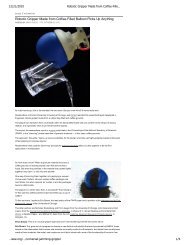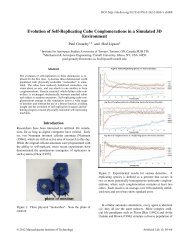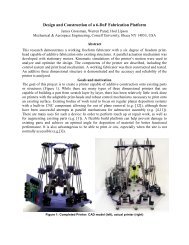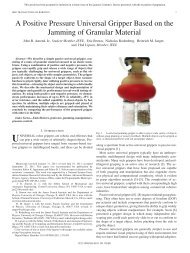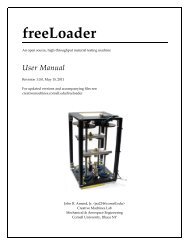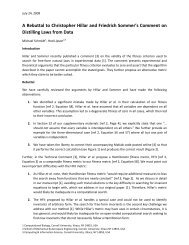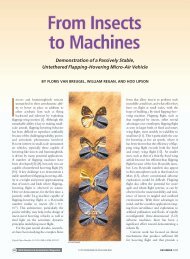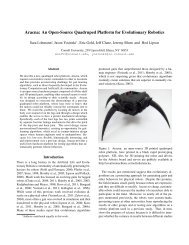Multi-material Freeform Fabrication of Active Systems - Cornell ...
Multi-material Freeform Fabrication of Active Systems - Cornell ...
Multi-material Freeform Fabrication of Active Systems - Cornell ...
Create successful ePaper yourself
Turn your PDF publications into a flip-book with our unique Google optimized e-Paper software.
systems could enable invention, prototyping, and<br />
manufacturing <strong>of</strong> an entirely new space <strong>of</strong> product and device<br />
designs in which geometry and functionality (including active<br />
electromechanical, chemical, and biological functionality) can<br />
be continuously varied and intertwined.<br />
A consumer-oriented fabber, coupled with the networked<br />
educational and technical resources already available today,<br />
could empower individuals with much <strong>of</strong> the innovative facility<br />
that would otherwise require an entire R&D laboratory. This<br />
could potentially lead to economic innovations such as neocottage<br />
industry manufacturing, an “eBay <strong>of</strong> designs” where<br />
individuals can market unique product designs as digital<br />
instructions and <strong>material</strong> recipes for others to execute on their<br />
own fabbers, and millions <strong>of</strong> people inventing technology<br />
rather than merely consuming it.<br />
Despite the aforementioned potential, commercial SFF<br />
technology is still focused on producing passive mechanical<br />
parts in one or two proprietary <strong>material</strong>s, and the emphasis <strong>of</strong><br />
commercial R&D has been on improving the quality,<br />
resolution, and surface finish <strong>of</strong> parts, and on broadening the<br />
range <strong>of</strong> useable <strong>material</strong>s. Growth in the market for and<br />
capability <strong>of</strong> commercial SFF technology has been<br />
disappointingly slow – commercial systems have been<br />
available for more than two decades [17], yet worldwide annual<br />
sales <strong>of</strong> systems are still measured only in thousands [18]. SFF<br />
systems remain very expensive and complex, and are used<br />
primarily by corporate engineers, designers, and architects for<br />
prototyping and visualization and for manufacturing a limited<br />
range <strong>of</strong> end use parts. These factors are linked in a vicious<br />
cycle which slows the development <strong>of</strong> the technology: Niche<br />
applications imply a small demand for machines, restricting<br />
commercial R&D and adoption <strong>of</strong> the new capabilities<br />
demonstrated in the laboratory, while small demand for<br />
machines keeps the machines costly and complex, limiting<br />
them to niche applications.<br />
As will be presented, we are working to free SFF<br />
technology from this trap, and to accelerate the development <strong>of</strong><br />
fabbers by:<br />
1. developing a research SFF system which is<br />
capable <strong>of</strong> employing multiple SFF processes<br />
and many <strong>material</strong>s in the course <strong>of</strong> building a<br />
single object,<br />
2. developing <strong>material</strong>s and designs which allow us<br />
to produce a wide variety <strong>of</strong> functional products<br />
and even complete electromechanical devices<br />
entirely within this single SFF system, and<br />
3. involving the public in developing novel<br />
applications for and innovations in fabbing<br />
technology by designing the Fab@Home Model<br />
1 Personal Desktop Fabricator– an inexpensive<br />
multi-<strong>material</strong> fabber which individuals can<br />
build from a kit, operate, and experiment with,<br />
using free and open-source designs, instructions,<br />
and s<strong>of</strong>tware we provide via a website.<br />
2. RESEARCH SFF SYSTEM<br />
Our multi-<strong>material</strong> freeform fabrication research platform<br />
(Figure 1) consists <strong>of</strong> a 3-axis Cartesian gantry robot, two<br />
changeable <strong>material</strong>-deposition tools, and a s<strong>of</strong>tware<br />
application which processes assemblies <strong>of</strong> STL files into a<br />
multi-<strong>material</strong> manufacturing plan and executes the plan on the<br />
system hardware. Since our first publication on the system [14],<br />
we have reengineered both tools and improved the s<strong>of</strong>tware to<br />
enhance deposition control, speed up changes <strong>of</strong> <strong>material</strong>, and<br />
simplify manufacturing <strong>of</strong> complex multi-<strong>material</strong> objects.<br />
Figure 1. <strong>Multi</strong>-<strong>material</strong> SFF research platform; (a) CAD<br />
rendering <strong>of</strong> the Cartesian gantry positioning system, (b)<br />
photograph <strong>of</strong> actual system with syringe-deposition tool mounted,<br />
(c) components <strong>of</strong> syringe-deposition tool, and (d) components <strong>of</strong><br />
molten-extrusion tool.<br />
The XY-axis gantry moves the mounted tool along planned<br />
deposition paths, while the Z-axis table moves downward to<br />
accommodate deposited <strong>material</strong> layers (Figure 1(a, b)). One<br />
tool (Figure 1(c)) employs syringe-deposition (“robocasting”) to<br />
deposit streams (“roads”) <strong>of</strong> <strong>material</strong> 250-1500µm in diameter,<br />
depending on <strong>material</strong> properties and resolution/fabrication<br />
speed trade<strong>of</strong>f. It is compatible with an enormous range <strong>of</strong><br />
liquid, gel, or paste <strong>material</strong>s, and employs a linear stepper<br />
motor to achieve volumetric dispensing, at up to 1.1MPa<br />
(160PSI). We have redesigned it to dispense from 10mL<br />
disposable syringes mounted in easily changeable cartridges in<br />
order to facilitate rapid <strong>material</strong> changes. The second tool<br />
(Figure 1(d)) employs a molten-extrusion (FDM®) process,<br />
which entails feeding thermoplastic or low-melting point<br />
eutectic alloy feedstock in wire-form into a heated nozzle. This<br />
tool extrudes a fine strand (typically 150-200µm diameter) <strong>of</strong><br />
molten <strong>material</strong> which quickly solidifies, and now has active<br />
feedstock cooling, an optimized pinch roller tooth design, and a<br />
2 Copyright © 2008 by ASME


